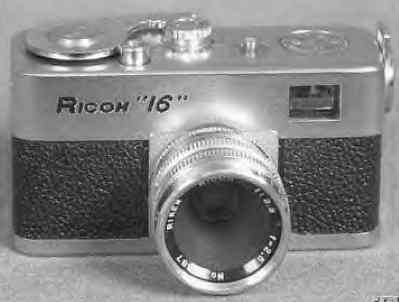
RICOH 16mm SUBMINIATURES
The Steky and the Ricoh used the same lens mount so the Steky lenses will
fit on the Ricoh and vice-versa. But there is a certain confusion
surrounding the lens mount on these cameras. Certain authors have written
that these cameras will accept movie cameras lenses. This has increased the
demand for these cameras, but the rumor is not true. While it is true
that most of these cameras have an interchangeable screw mount lens, it is
not compatible with standard movie lenses. Movie lenses come in two
universal scrw mounts mounts called "C" and "D". The C mount was designed
for 16mm movie cameras and is is 1 inch wide (25.4mm) with a pitch of 0.03125
inches (0.79375mm). The smaller D mount was designed for 8mm cameras
and is 5/8 inch wide (15.875mm) with the same pitch. It's hard to imagine
that the Steky would have been made with either type of movie lens in mind.
First, the Steky was designed in Japan just after World War II. The
country used the metric system, not inches, and at that time the country
was impoverished. Everything, including photography, was very expensive.
The Steky camera was made small so that it would be inexpensive to
use. It is inconceivable that they would have designed the camera for
expensive movie lenses that no one could possibly afford and were impossible
to find anyway. Similarly, it was built to be a subminiature camera.
Movie lenses of the time were all large and heavy -- completely
inappropriate for a camera of that size. Some authors have written that the
cameras used C mount lenses, some say D mount lenses, and others just say
"movie lenses". But the Steky obviously was not designed for either.
The C mount lenses, which are designed for cameras that used 16mm
film -- just like the Steky -- are way too big for the camera mount.
The C mount is nearly 25mm wide while the Steky lens mount is on 16mm.
The C mount lenses are actually wider than the Steky camera body!
And although the D mount lenses will loosely fit on the Steky body
(which has a screwmount size of 16mm with a pitch of 0.5mm), you are asking
for trouble. First, since the D mount lenses are designed to be used
with 8mm cameras, not 16mm like the Steky, you won't be able to focus an
image on the film. The lens needs to be much closer to the film than
the Steky body allows. More importantly, if you try to put a D mount
lens on a Steky, you risk stripping the threads on the camera body, and thereby
rendering the camera completely useless. So ignore all these authors,
even if they show you pictures of a movie lens on a Steky. A few specialty
lenses were made for the Steky, but these are few and far between. Just
be happy that Steky/Ricoh made good quality cameras and that these subminis
are still easy to purchase today.
The first few generations of Steky cameras used two small cassettes for film
-- we'll call this the Steky cassette.. The later Steky/Ricoh's used
a much larger double-lobed cassette that we'll refer to as the Ricoh cassette.
The Steky cassette will not fit in the later cameras, nor will the
Ricoh cassette fit in the earlier cameras.
-
(1957) -- Same as the Golden Steky. Interchangeable, fixed-focus 25mm
(f3.5-16) lens. The focus is fixed at around 12 feet and had adequate
depth-of-field. Speeds of B, 1/50-1/200. The camera
was redesigned to look like a small rangefinder camera. To add to the
appeal, the camera had a bright gold finish -- real gold plating!. Even the
viewfinder (with marks for the tele lens) is gold tinted. A gold-plated 40mm
telephoto lens was available, but apparently in different styles. We
have read about f4.5 and f5.6 versions. The f5.6 version is a focusing
lens (as is the f4.5) and focuses from 3.5 feet to infinity. It did not have
a filter thread on the front. The camera has flash synch. With
a threaded cable-release socket and tripod socket this is a very capable
camera.
-
If you have any ideas, suggestions or comments about these pages, please
contact the Sub Club at the FRONT
DESK.
To return to the main index for the Sub Club click
here.
COPYRIGHT @ 1995, 1996, 1997, 1998, 1999, 2000, 2001, 2002, 2003, 2004, 2005 by Joe McGloin. All Rights Reserved.


